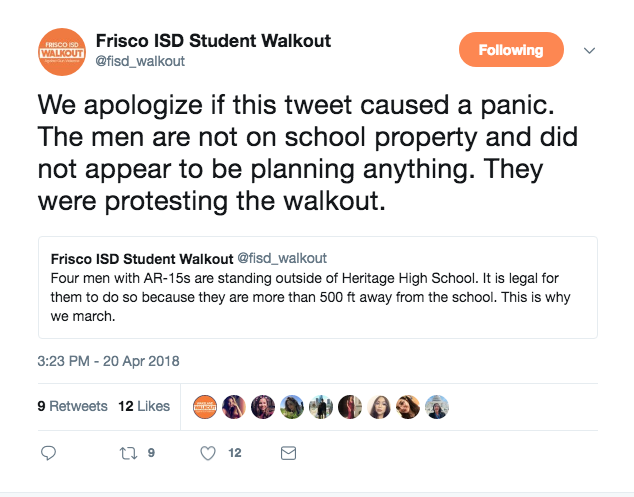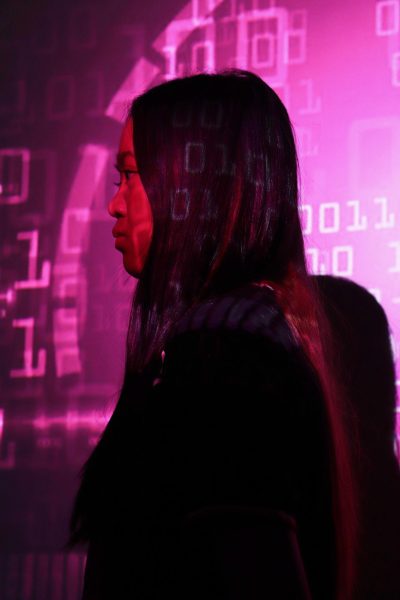Protective Policies
Student Journalist reports information about Frisco ISD’s School Safety and Gun Regulation Policies
A screenshot of a tweet taken from the FISD National Walkout twitter page. The FISD Walkout was not affiliated with the district.
May 17, 2018
Student journalist Shreya Chari asked parents, students, and teachers of FISD to ask questions they had about the district’s policies on school safety and gun regulations. Of the questions, received she chose four insightful questions and wrote news stories for each, developing them into a Q&A format.
Question:
How does the backpack policy at Heritage help with school safety?
Answer:
Heritage High School’s backpack policy, which has been in place since the school opened in 2009, is intended to limit the number of items students carry with them on campus.
Under the rule, which falls under Frisco ISD policy, students are allowed to take backpacks to school, but they must keep them in their lockers.
“Before [Heritage] was open, the schools did allow backpacks,” Principal Mark Mimms said. “Then the district went away from that because they realized that students carry everything; they don’t just carry books. Their backpacks were so full of things that if they stood back to back it would block the entire hallway, and we couldn’t have that.”
School administrators keep an eye out for repeat offenders, and the punishment for taking a backpack to class can range from tardies to Suspension on Campus (SOC).
“If someone is caught bringing dangerous items to school, the police could get involved,” Mr. Mimms said. “When that happens, the police run their investigation, we run ours, and there could be a number of things leading up to an SOC.”
Some students don’t like the policy because they found it inconvenient to carry their belongings and they had gotten used to carrying backpacks in middle and elementary school. Still, most of them comply with the rule.
“I had a large purse that I was used to carrying around, and now I carry a drawstring,” junior Nuha Siddiqui said. “So there was that initial annoyance about this change, but for the most part I felt like it was something that was easy to adjust to. We [student body] are cooperating because we know there’s a bigger picture that we need to consider.”
That “bigger picture” is another reason that the school administrators enforce the policy so much: keeping weapons off campus.
“I know they can bring [illegal] things on their person as well, but a lot of people use their backpacks,” Mr. Mimms said. “Somebody could do something, and we would have no way of knowing.”
While the backpack policy has been a school rule for almost a decade, students say it seems like the school has enforced it more closely in recent months, following a string of school shootings nationwide.
“My freshman and sophomore years, there were some consequences [for not following the rules],” Siddiqui said, “But they were a lot more lenient than they are now. It’s sad that [our schools] have to take these measures. However, new events are always happening, and you have to adjust to what’s going and take precautionary measures.”
Mr. Mimms said the policy isn’t up for review, but he does believe it’s important to explain the rationale for it to students.
“I’ve always believed that discipline is about discipling yourself rather than being disciplined,” Mr. Mimms said. “I think that we should tell our students why we enforce these policies. They’re not just arbitrary decisions.”
Siddiqui says she isn’t sure that the backpack policy is the best way to prevent dangers or threats at school, but that it does send a cautionary message to students.
“Even with drawstrings there is the potential of someone bringing in a weapon,” Siddiqui said. “But I feel that having that boundary, even if it’s not a whole lot, is still that underlying thing where people will reconsider having or bringing these items to school just because the policy exists.”
Question:
What as students/teachers can we do besides lockdown drills to assure we won’t be hurt?
Answer:
The district has a partnership with the city of Frisco called SAFER, which allows first responders live access to cameras in and out of FISD campuses. To promote response activity among students and staff, a SAFER drill is practiced once on each campus annually.
“SAFER has been in the District for 10 years and been presented at various town hall meetings, board meetings and city events,” FISD Director of Security Kevin Haller said. “Some campuses have also shared it with parents/students on occasion.”
FISD implemented other plans that help promote school safety, including having a single point of entry, having all visitors check in, keeping a crisis team on all campuses and hiring a school resource officer at all secondary schools.
“There is a plan for several types of incidents that may occur on a campus,” Mr. Haller said. “But you can’t plan for every possible scenario someone may create.”
To learn more about S.A.F.E.R., visit: http://www.friscoisd.org/departments/security/community-partnerships
Still though, lockdown drills are the school district’s most common safety drills. To teach students proper protocol in the event of a school threat, administrators conduct four lockdown drills each year, which is twice the recommended amount by the state.
“Anytime there’s a threat to the school, there are several things you have to do,” Heritage Principal Mark Mimms said. “Once that threat is imminent, you have to do things in a purposeful way.”
While the lockdown drill is conducted many times over the year, it’s always during the same time of day, usually on the same day of the week.
“It’s beneficial because students and teachers get frequent reminders about what to do [in this situation],” said Chelsey Skelton, who teaches AP Language and Composition. “But I also think we should have some variation in the time of day that we do them, and make it a little less ‘routine’, because we always do it with the same class. It’d be good to know what to do in other situations.”
Though the repetitive drills have become a pattern for the students, said Mr. Mimms, the continual practice is crucial for students to follow.
“I want students to be quiet and take [lockdown drills] seriously,” Mr. Mimms said.“Because if someone hears a noise from a room when the lights are out and door is locked, they don’t know if anyone is even in the room and they’ll move on.”
The lockdown drill has been implemented since the Columbine shooting in 1999, which also prompted the start of many more safety drills, Haller said.
“We are always looking at best practices and meeting with other districts to see what they are doing,” Mr. Haller said.
Question:
Is there a districtwide plan for arming teachers? What are FISD’s thoughts on the matter?
Answer:
The Frisco Independent School District does not support arming teachers in the name of school safety, said Kevin Haller, Director of Security. After considering the controversial proposal, the district decided against the move because of lack of support from local law enforcement officials.
“FISD works closely with law enforcement on issues related to school security and emergency response,” Mr. Haller said. “Local police do not support this idea, as it can be difficult to distinguish between a threatening and non-threatening individual with a gun.”
Proponents of arming teachers argue that doing so would limit the damage a shooter could do on campus, but FISD officials said that potential benefit is overshadowed by other possible dangers.
“More guns in schools could create collateral damage in that accidents will inevitably occur,” Mr. Haller said.
The controversial suggestion has not only made teachers wonder about whether they’d be comfortable carrying a weapon on campus, but also about how their students would feel in a classroom where their teacher carries a weapon.
“Thinking as a teacher, not even on a political level, if I’m a student and my teacher carries a weapon, saying it’s for my protection, I won’t be worried about the one in a million chance that someone will come and shoot up the school,” said Leah Waters, Yearbook Adviser and Journalism Teacher. “I’d be worried about everyday that that teacher is bringing a lethal weapon to school.”
While the district doesn’t arm its teachers, it does assign law enforcement officers on each campus.
“Frisco ISD employs school resource officers [at each campus],” Mr. Haller said. “We are fortunate to live in a community with fast emergency response times.”
Question:
Does the school security officer have access to kids’ social media to evaluate any worrisome activity?
Answer:
Frisco Independent School District administration does not have a policy that allows its security officers to “friend” Frisco students on social media to keep an eye on them and evaluate activity, even though occasionally reports are made about certain students’ social media activity.
But junior Kundai Nyamandi said having someone on the lookout for social media has been valuable in the past.
“When I was at Maus Middle School, someone threatened to shoot up Maus on social media,” Nyamandi said. “The police found out, he was put on house arrest and the whole situation was avoided. But what would’ve happened if they hadn’t found out through social media?”
Still, having someone check in with student activity every day on social media may not have the desired effect.
“It would definitely impact student expression on social media,” Nyamandi said. “Especially if they knew the district was watching them. I think it would make a lot more people paranoid and not want to express themselves, and I know a lot of people use [social media] to escape or post things about themselves that they don’t really talk about in person.”
In order to help protect students and raise awareness of what is being talked about, principal Mark Mimms uses social media accounts.
“My role in the school is to keep students as safe as possible,” Mr. Mimms said. “[I want to know] things ahead of time. I have all the social media students have, not to stalk them, because I want to know if something is being talked about.”
Creating social media accounts allowed for Mr. Mimms to be more prepared and stay on top of situations.
“Being proactive is extremely important in these situations,” Mr. Mimms said. “Talking to administration like us when the information is first known. If someone lets us know, maybe I could do something about it..”




